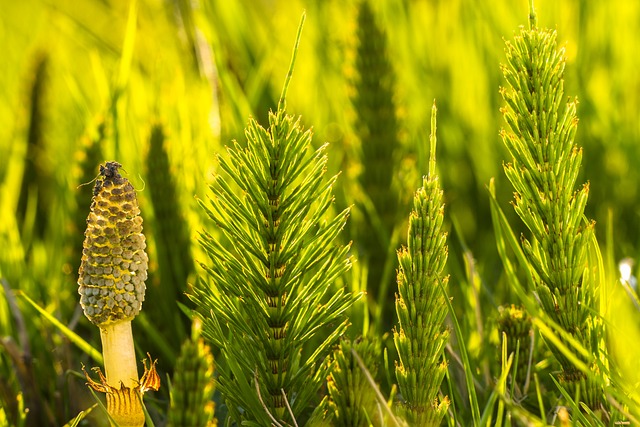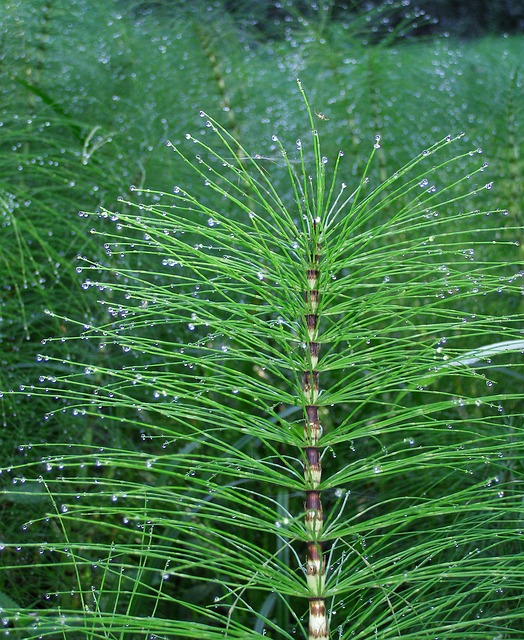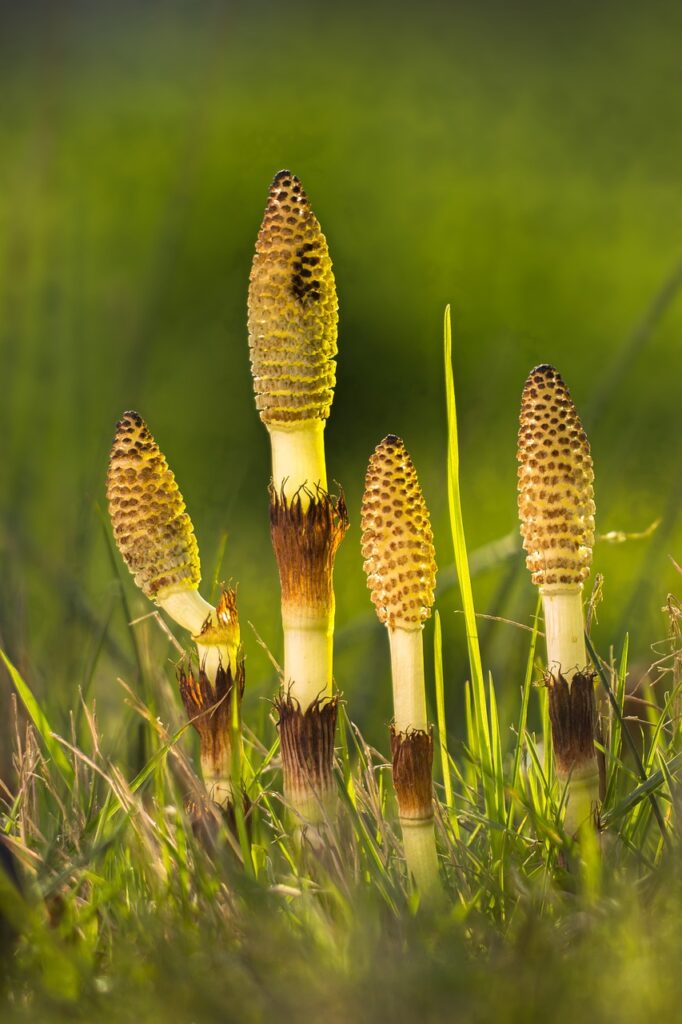Log in or create new account to save this product to your wishlist.
Recognise and Control Mares Tail in your garden: from Identification to Eradication
Mares tail (aka Horsetail) is an invasive weed with deep roots, which make it a real challenge to eradicate. Find out about this fascinating weed (and find out how to tackle the problem).
Latest articles
7 MIN 22 Jul How to keep your lawn in shape this summer 9 MIN 15 Jul Watering Your Garden: 10 Top Tips! 11 MIN 15 Jul Is Your Grass Type Right for your Garden? 11 MIN 10 Sep Create Your Low-Maintenance Garden – Tips and Ideas 11 MIN 08 Sep The Ultimate Guide to Choosing the Perfect Hedges for Your Garden 12 MIN 30 Aug The Top 20 Evergreen Climbers to Transform Your GardenHorsetail, also known as mares tail, is an invasive weed that can wreak havoc in British gardens.
- What is Mares Tail?
- Why is Horsetail a Problem?
- How do you identify Mares Tail?
- Strategies to Control Mares Tail
- Safe and Effective Chemical Use
- Where does Horsetail come from?
- FAQs
- Any questions
And while some consider this prehistoric plant attractive, the plant’s rapid growth and deep roots make it challenging to manage and control once established.
This article explores how to identify and control mares tail in your garden, sharing how to eradicate it for good!
Ready? Let’s go!
What is Mares Tail?

Mares tail (Equisetum arvense), often referred to as Horsetail, is a perennial plant native to arctic regions and parts of the northern hemisphere. It’s distinct from the aquatic plant Hippuris vulgaris, also commonly known as mare’s tail. And although these terms are sometimes used interchangeably, they represent two different plants.
Horsetail has a rich history — believed to have existed around 350 million years ago, earning it the tag of a “living fossil”.
The plant thrives on land, forming dense clusters of dark green foliage that compete with other plants for resources and nutrients.
One of the most significant challenges with mares tail is its deep roots, or rhizomes, which delve up to two metres underground, making it highly resistant to herbicides.
The plant propagates through its rhizomes or spores, contributing to its invasiveness.
Why is Horsetail a Problem?

A weed is typically defined as an unwanted plant that is difficult to manage and competes with desired plants for garden resources. And Horsetail fits this description perfectly due to its vigorous growth patterns.
And once mares tail establishes itself in a garden, it can crowd out other plants.
Moreover, attempts to uproot or cut it back often prove futile, as rhizomes are waiting deep underground, ready to sprout again.
So, given its ability to burrow deep and spread between gardens, mares tail has earned its reputation as one of the most formidable weeds in the UK.
Some of the problems associated with a horsetail infestation include:
- Structural damage to pavements, footpaths, and walls
- The deep root system goes down as deep as 2 metres, making removal extremely challenging
- Nutrient deficiency in your soil
How do you identify Mares Tail?

Before formulating a control strategy, it’s crucial to confirm if the plant in question is indeed mares tail.
The weed grows between 0.1-1m in height, with fir tree-like side shoots, which branch out from segment joints in distinctive brown-coloured “spore cones”.
While looking quite exotic, it’s the spreading behaviour that you really have to watch out for!
Strategies to Control Mares Tail

If your garden has fallen victim to a mares tail infestation, there are several techniques you can adopt to manage its spread.
I believe that chemical use should be a last resort. The best ways to keep your garden clear of pests and diseases are to develop good gardening practices, such as:
- Strict cultivation methods
- Specific cultivar selection
- Effective garden hygiene
- Encouraging or introducing natural enemies, such as nematodes, wherever appropriate
As a last resort, some UK councils, such as Preston, offer reporting programs to monitor the presence and spread of mares tail in the local area. If such a program exists in your area, it’s beneficial to report the infestation.
Cultural Control of mares tail
Removing mares tail by hand is a strenuous task, given the depth of its roots. While you can remove the surface rhizomes, deeper roots require considerable digging.
And as is the case with many weed varieties, shallow weeding can exacerbate the problem as any small pieces left behind will regrow — potentially spreading the plant even further.
However, removing shoots as soon as they appear above the ground can lessen infestation over several years.
For mares tail appearing in lawns, regular mowing can keep it in check.
Chemical Control of Horsetail
Weakening mares tail with weedkiller is another effective method. However, I’m not a fan of chemical overuse in the garden, so use this as a last resort.
When using chemical control, consider the following:
- For vacant soil with no herbaceous perennials, bulbs or crops, use products containing glyphosate/diflufenican
- Apply tough weedkillers containing glyphosate in late summer when growth is at its peak. However, bruise the shoots with a rake before application for adequate penetration.
Remember, mares tail is persistent. Several applications — possibly over several years — may be necessary to eradicate the problem completely.
Can Vinegar Kill Mares Tail?
No, vinegar is not an effective solution for mares tail. Its mild acidity doesn’t cause sufficient damage to kill the plant.
Can You Dig Up An Entire Mares Tail?
While theoretically possible, it would be incredibly laborious due to the plant’s wide-spreading and deep-burrowing rhizomes.
Should You Trim Mares Tail?
Trimming mares tail can help manage its above-ground growth. However, it does not address the root of the problem – the deep underground rhizomes.
Safe and Effective Chemical Use
When using chemicals, following the given guidelines is crucial to ensure safety and effectiveness.
These include:
- Using a high-quality sprayer with accurate directionality
- Following the guidelines for safe and effective chemical use
- Choosing between spot-on and broad-scale weedkillers according to nearby plants
Before using any weedkiller product, it’s essential to follow the instructions on the label to the letter.

- Offers excellent control and directionality
- Pump-action
- Available in three sizes!
Where does Horsetail come from?
Horsetail appears in beds, lawns, borders, patios, and paths and often seems to appear from nowhere. However, most plants emerge due to deep rhizomes that have spread from neighbouring gardens.
Alternatively, you may have unwittingly brought the plant into your garden in composts or manure, which may contain tiny stem fragments that develop into full plants.
However, perhaps the most likely way for Horsetail to spread if there aren’t other nearby plants is in the wind, which can distribute the plant’s spores for broader distribution.
FAQs
Removing an established horsetail (or mares tail) plant can be challenging, so it’s better to address the problem as soon as the first shoots appear. Rip up the shoots and dig down into the soil to remove as much of the rhizome as possible. However, the plants’ root networks are deep, so you may need to dig down as much as two metres!
Removing an established horsetail (or mares tail) plant can be challenging, so it’s better to address the problem as soon as the first shoots appear. Rip up the shoots and dig down into the soil to remove as much of the rhizome as possible. However, the plants’ root networks are deep, so you may need to dig down as much as two metres!
Horsetail (aka mares tail) has anti-inflammatory properties, as well as antibacterials and antimicrobial benefits when prepared correctly. However, the plant needs to be strictly prepared before you can ingest it.
Any questions
I hope I’ve provided all the questions you might have about this fascinating weed, but if you have questions, don’t hesitate to get in touch.
Or check out our encyclopedic Help & Advice section for more expert gardening tips.
Controlling Horsetail can be challenging, given its invasive nature and deep roots. However, by adopting a mix of cultural and chemical control methods, you can effectively manage its spread and even eradicate it over time.
Thanks for reading!
Leave a comment
Your answer will be displayed on the site and the interested party will be notified by email.
Leave a comment
Have a question or want to share your experience? Leave us a comment.
Read more
The best tips and tricks for a lush green lawn
 7 MIN
13 Sep
Lavender Cuttings: a step-by-step guide
7 MIN
13 Sep
Lavender Cuttings: a step-by-step guide
 11 MIN
10 Sep
Create Your Low-Maintenance Garden – Tips and Ideas
11 MIN
10 Sep
Create Your Low-Maintenance Garden – Tips and Ideas
 Scarifying Kit
All products after scarifying | Quickly restores the lawn after scarifying | Outsmart weeds quickly with the use of this kit
From: € 39.99
Scarifying Kit
All products after scarifying | Quickly restores the lawn after scarifying | Outsmart weeds quickly with the use of this kit
From: € 39.99
 Spring Lawn Care Kit
MOOWY’s choice for the spring | Quick recovery of your lawn after winter | A strong lawn prevents weeds
From: € 25.99
Spring Lawn Care Kit
MOOWY’s choice for the spring | Quick recovery of your lawn after winter | A strong lawn prevents weeds
From: € 25.99
 Long Lasting Lawn Fertiliser
Effective for 90 days | See results in 14 days! | Suitable for all types of grass and soil
From: € 13.99
Long Lasting Lawn Fertiliser
Effective for 90 days | See results in 14 days! | Suitable for all types of grass and soil
From: € 13.99
Do you want a lawn calendar?
🌱 All important maintenance moments for your lawn during the year. Leave your email and we will send you the lawn calendar for free.
Enter your email
Receive the lawn calendar in the mail
Enjoy a green lawn all year round!










Comments (0)
There are no comments yet. Well then, what are you waiting for to
Be the first to write your comment!inaugurate this pretty page?
Do you have some comments?